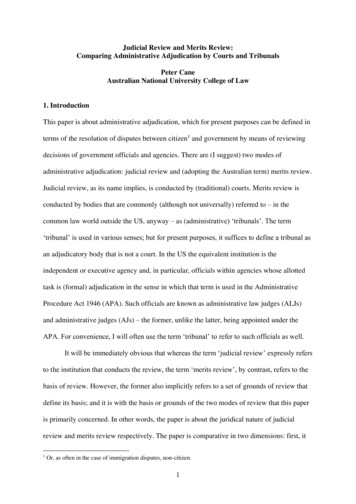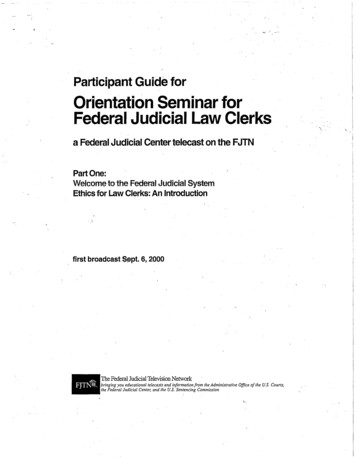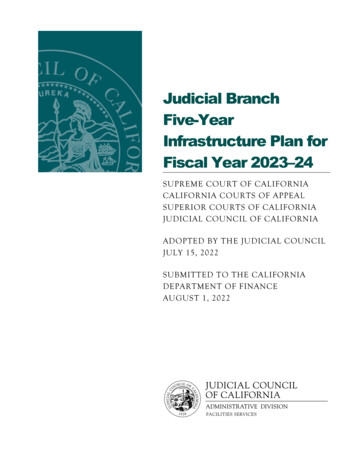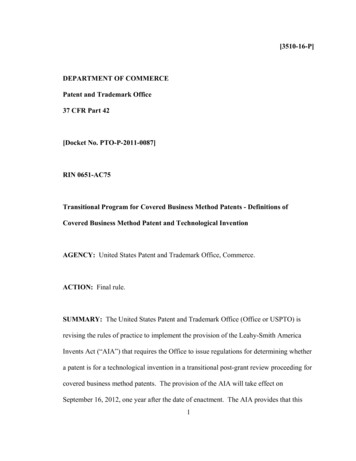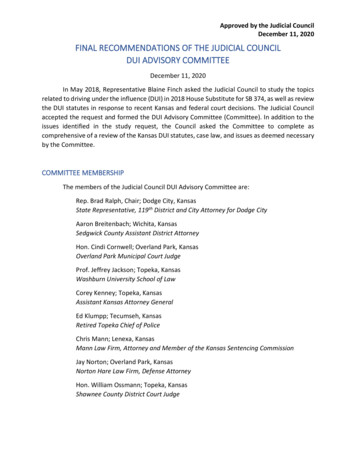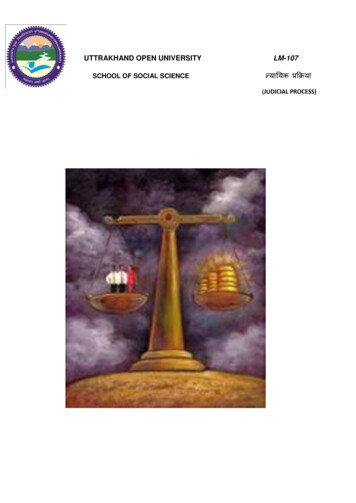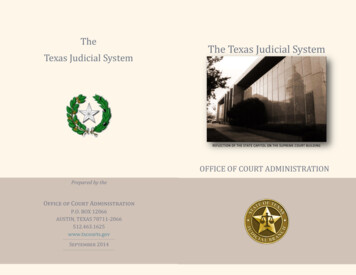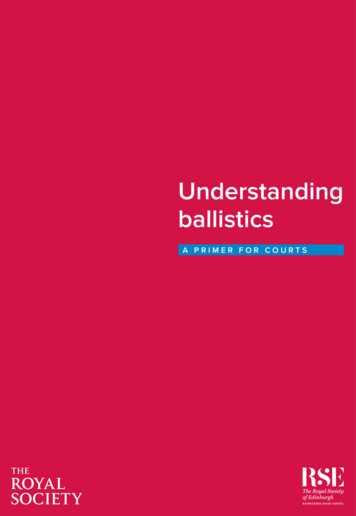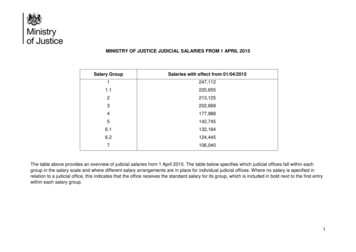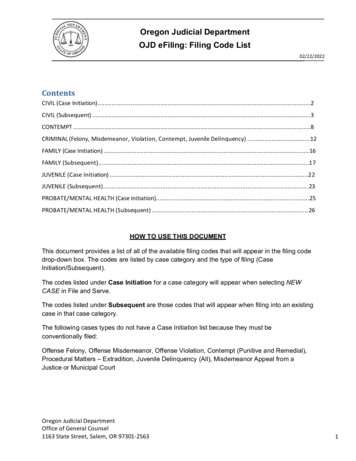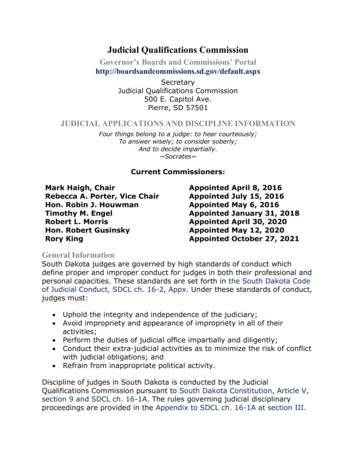
Transcription
JUDICIAL REVIEW PRACTICE DIRECTION3/2018Page NoPreface3General3PART APRE-PROCEEDINGS4PART BPRE-LEAVE5-9PART CPOST-LEAVE10 – 11PART DBUNDLES OF DOCUMENTS12 – 14PART ESTANDARD DIRECTIONS15 - 16PART FSKELETON ARGUMENTS17Note: Some of the requirements contained in the individual Parts of this PracticeDirection extend beyond the section in which they appear.APPENDIX IPre Action Protocol18-26APPENDIX IIThe Order 53 Pleading27-35APPENDIX IIIService on Northern Ireland Departments36-37APPENDIX IVService on Authorised Government Departments38-41APPENDIX VAffidavits and exhibits42-47APPENDIX VISkeleton arguments48-51APPENDIX VIIHuman Rights Act 199852-531
APPENDIX VIIIDevolution Issues54APPENDIX IXPublic Funding55APPENDIX XCompassionate Temporary Release and related cases 56-582
Preface[1]The central themes of this revised Practice Direction are partnership, cooperation, efficiency and expedition. Judicial review is a distinctive speciesof litigation. It lacks many of the trappings of private law litigation. This isreflected, firstly, in the notion of partnership with the Court. Every partyand all representatives should be conscious of this partnership and itsimplications at every stage. It is illustrated particularly in the supremelyimportant duties of candour and co-operation. The related themes ofefficiency and expedition require no elaboration. At heart they are designedto ensure that the principles enshrined in the over-riding objective are at theforefront of every case, from initiation to completion. The parties and theCourt share the common aim of processing every case in a manner whichmakes the best possible use of the Court’s limited resources and bringsabout an outcome within reasonable timescales, consistent with everyparty’s inalienable right to a fair hearing.General[1]This Practice Direction, issued with the approval of the Lord Chief Justice(NI), supersedes its predecessor (issued on 16 January 2006, revised on 30September 2008 and 10 October 2013).[2]This Practice Direction complements, but does not modify or amend, therelevant provisions of the Rules of the Court of Judicature (“RCC”), inparticular – but not limited to – Order 53.[3]Familiarity with RCC Orders 1, 24, 38, 41, 53, 54, 59, 62, 119 and 120 isessential for all judicial review practitioners.[4]It is not the function of the Judicial Review Office (the “Office”) to preparebundles or print papers for Judges. Exceptions to the latter will be madeonly in compelling circumstances and upon judicial direction.[5]Practitioners are urged to limit electronic communications with the Office tothe absolutely essential. Part G of this Practice Direction will be strictlyapplied in every case.[6]All email communications with the Office should be addressed only tojudicialreviewoffice@courtsni.gov.uk.3
Part A Re Pre-action Protocol(1)The Pre-Action Protocol (“PAP”) is at Appendix I. It is an integral part ofthis Practice Direction.(2)The PAP letters in Appendix 1 will be used in every case. They contain theminimum contents and are not intended to preclude inclusion of othersignificant content.(3)The duty of strict compliance with the PAP applies in every case, except inthe most urgent or compelling circumstances and irrespective of whether theproposed Respondent is legally empowered to revoke or alter the impugneddecision or action. Judicial direction should be promptly and proactivelysought in every such case.(4)The PAP mechanism has among its aims the avoidance of litigation wherethis can be achieved. Having regard to the time limit of three monthsprescribed by RCC Order 53, Rule 4, it is essential to specify certain timelimits belonging to the PAP phase. To this end, as a general rule:(a)The putative Applicant’s PAP letter will be transmitted not later than7 weeks following the date of the impugned decision, act or measure.(b)The agency or agencies to whom the Applicant’s PAP letter isdirected shall respond within the ensuing period of 3 weeks.(5)Parties and practitioners are reminded that neither the Court nor the Officehas any function of any kind until proceedings are initiated and lodged.(6)Any failure to comply properly with the PAP may have (inter alia) adversecosts implications for the defaulting party or its representatives.4
Part B: Initiating Proceedings, the Order 53 Pleading, Serviceand the leave stage generallyPrefaceThe Applicant’s pleading is a vital element of every judicial review case. This isreflected in the model Order 53 Statement at Appendix II. Concision, clarity,precision and adequate particularity are the supreme requirements of every Order53 pleading.(1)An application for leave to apply for judicial review must be made bylodging (under O53 R3(2)) (i)an ex parte docket;(ii)an Order 53 Statement;(iii)affidavit(s) (and exhibits).(2)The model Order 53 Statement at Appendix II must be used in every case,without exception.(3)Every Order 53 Statement will be completed in an electronic format whichallows electronic transmission to the Office in urgent cases and permits anylater necessary revisions.(4)Any request for urgent or expeditious consideration must be clearlyhighlighted in both the Order 53 Statement and in separate communicationwith the Office.(5)Every application for leave to apply for judicial review must be served onboth the Office and the proposed Respondent or its notified or usual legalrepresentatives, complying strictly with the service provisions ofAppendices III and IV hereof.(6)There will be cases in which the Applicant will be expected to also serve thejudicial review leave application on a person or agency with an obviousinterest in the subject matter of the proceedings.(7)Every application for leave to apply for judicial review will be determined inone of three ways:5
(a)On the papers, where the Court is proposing to grant leave withoutany form of hearing.(b)At an ex-parte hearing: this is likely to be reserved to cases ofexceptional urgency or possessing some other special or compellingfeature.(c)At an inter-partes hearing attended, upon the invitation of the Court,by the proposed Respondent and any non-party so invited.(8)The Court, prior to determining the leave application, may, at its discretion,invite the proposed Respondent and/or any non-party on whom theapplication has been served to set forth their response to the Applicant’scase in writing, either generally or in such specific respects as may bedirected.(9)Where the proposed respondent is a Northern Ireland department thesolicitor and address for service are the Departmental Solicitor’s Office,Centre House, 79 Chichester Street, Belfast BT1 4JE. See Appendix III.(10)Where the proposed respondent is an Authorised Government Departmentthe solicitor and address for service are the Crown Solicitor’s Office, RoyalCourts of Justice, Chichester Street, Belfast BT1 3JY. See Appendix IV.(11)Where the proposed Respondent is a statutory body involved in theprovision of health or social care, the solicitor and address for service are theChief Legal Advisor, HSC Business Services Organisation, Directorate ofLegal Services, 2 Franklin Street, Belfast, BT2 8DQ.Immigration and Asylum Cases – Challenging Removal Or Deportation.(12)Every application for leave to apply for judicial review and/or interim reliefor expedition must be accompanied by –(i)A copy of the removal directions and the decision to which theapplication relates;(ii)Any document served with the removal directions including anydocument which contains the Immigration and NationalityDirectorate’s factual summary of the case;(iii)If the applicant is unable to comply with (i) and (ii) above, a statementof the reasons why.6
(iv)Particulars of the time/date/method of service of the papers on theproposed Respondent or its representative.The Leave Bundle(13)Every leave application bundle shall:(a)Have as its first page an index describing fully and coherently eachelement of the contents.(b)Be paginated from beginning to end.(c)Be composed in the following manner and sequence: Ex parte docket. Certificate of Urgency, where appropriate, accompanied by theApplicant’s draft interim relief order. Order 53 Statement, accompanied by proposed litigationtimetable and, where appropriate, any Certificate of Legal Aid. Each supporting affidavit, every affidavit to be followed by itsparticular exhibited documents. PAP correspondence (always the final components).Affidavits and Exhibits(14)Practice Direction 5/2005 (“PD5”) issued by the Lord Chief Justice on 25July 2005 on “Preparation of Affidavits and Exhibits” applies to affidavitsand exhibits filed in judicial review proceedings. The relevant text is inAppendix V.(15)Every affidavit will have one exhibits sheet. The documents thus exhibitedwill be identified and described in the composite index specified in [13] (a)above.(16)Every affidavit shall, in addition to complying with RCC Order 41 and PD5:(i)Comply with the deponent’s duty of candour to the Court.7
(ii)Consist exclusively of averments of fact.(iii)Avoid sworn argument.(iv)Avoid mere comment.(v)Avoid repetition of previous sworn averments and quotations fromother affidavits(vi)Omit reference to any statutory provisions or case law.(vii)Proactively and fully address issues such as urgency, expedition,anonymity, missing/unavailable material documents and delay.(viii) Will not exhibit legislation or cases.Urgent applications(17)Every urgent application for leave or interim relief or interlocutory reliefduring office hours may be arranged by email or telephone to the JudicialReview Office at –email address – judicialreviewoffice@courtsni.gov.ukTel Nos.028 90724685 & 028 90725917Note that during office hours the preferred means of contact is by email.(18)Urgent applications out of office hours may be arranged by telephone to theRCJ out of hours contact telephone number –Tel No 028 90724618or the Out of Hours Mobile phone number - which has been provided to legalpractitioners via the relevant channels.Note that applications out of office hours are exceptional, to be confinedto compelling cases where it is not possible for the matter to be dealt withduring office hours.8
(19)Urgent applications out of term must be accompanied by a Certificate ofUrgency, explaining WHY urgent processing is requested, signed byCounsel and lodged before any hearing, and may be arranged –(i)(during office hours) by email or telephone to the Judicial ReviewOffice at the contacts above.Note that during office hours the preferred means of contact is by email(ii)(20)(outside office hours) by telephone to the RCJ out of hours contacttelephone number above.Compassionate temporary release and kindred applications. Everychallenge by a prisoner to a negative compassionate temporary releasedecision and every kindred challenge shall be compliant with therequirements specified in Re McKee’s Application for Judicial Review [2018]NIQB 60 at [1] – [13]. These are reproduced in Appendix VII.Hearing Dates(21)The general rule is that the date for every hearing – leave, interim relief, casemanagement review, substantive adjudication et al – will be determined bythe Judge and notified to the parties/their representatives. The parties andtheir representatives are, however, strongly encouraged to proactivelycommunicate with each other and the Office from the earliest stage possiblewith a view to applying for an agreed hearing date or makingrepresentations in respect thereof.All such notifications andrepresentations, provided that they are timeously made, will be taken intoaccount by the Court.(22)Every prospective or actual judicial review Respondent and every interestedparty must pay particular attention to the timetable attached to the Order 53pleading, timeously and proactively engaging with all other parties/theirlegal representatives.(23)Every application to vacate or vary a hearing date of any kind will be madetimeously, in writing, containing the essential brief particulars and followingcommunication among all parties and their representatives.9
PART C: POST-LEAVENotice of Motion(24)Where leave has been granted an originating motion must be issued in 14days or leave lapses [RCC Order 53, R5(5)]. Where leave has lapsed anapplication for extension of time or for a further grant of leave must bemade by summons and an affidavit explaining the failure to issue and servethe notice of motion in time. The Court may order costs against the partywho has failed to comply with the time limits.Draft Orders(25)The relevant party will provide the Office with a draft order, containing allnecessary terms, and indicating the agreement or absence thereof of everyother party, in all such cases as are appropriate.(26)A draft order will be especially appropriate in cases where the parties/theirrepresentatives are agreed about the proposed course of action and, withoutprejudice to the generality of the foregoing, in the following instances inparticular:(27)(i)Interim relief.(ii)Protective costs.(iii)Timetabling matters.(iv)Final disposal.Every draft order relating to final disposal will include a recital or recitalsstating in concise and intelligible terms the basis of/reasons for the course ofaction/outcome which the Court is invited to sanction. In many cases thiswill entail a simple statement such as:“AND THE RESPONDENT having [provided OR done OR completed OR agreed to provide/do/complete] ‘X’ by ‘Y’ date .”10
(28)Where the parties are unable to agree on costs they shall proactivelyprovide, with the draft order, their competing written representations, not toexceed two A4 pages without the express prior permission of the Court.11
PART D: BUNDLES OF DOCUMENTS(29)Every leave application bundle compliant with the requirements specified inPart B above shall become Trial Bundle 1, Part II.(30)The Trial Bundle 1, Part I shall in every case consist of, in the followingsequence:(31) The Order 53 Statement, in final form, showing in colour anyamendments. The Notice of Motion. All Orders/directions of the Court from the inception of proceedings. Where appropriate: chronology, agreed schedule of material facts, listof dramatis personae, glossary. Skeleton arguments.Further regulation of Trial Bundle 1:(a)It will have a new covering index, reflecting its enlarged contents.(b)The pagination of Part I will be IA, IB etc.(c)The pagination of Part II will be unchanged.In this way Trial Bundle 1, Part II will be an exact duplicate of the leavebundle.(32)Trial Bundle No 2 will be an indexed and paginated compilation consistingof (a) any materials provided by the Respondent at the leave stage and (b)the totality of the Respondent’s affidavits and exhibited documents and willin every case begin with a comprehensive covering index.(33)Trial Bundle No 3 will contain the affidavit evidence and exhibiteddocuments of any authorised participating interested party and will complyfully with all of the aforementioned requirements.(34)In any case where the Applicant, with the permission of the Court, rejoins tothe Respondent’s affidavit evidence and documents:12
(35)(i)Trial bundle 1, Parts I and II will be as directed above.(ii)The Applicant’s rejoinder affidavit/s (where appropriate) andexhibits will be compiled as Trial Bundle 1, Part III, continuing thepagination of Part II and the covering index at the beginning of thebundle will be revised accordingly.(iii)Where for reasons of volume or otherwise the mechanism in (ii)above is not feasible, the Applicant’s rejoinder materials will beassembled in a new bundle, with a new covering index and newpagination and the bundle will be described as Trial Bundle No 3unless this is not practically feasible.(iv)The pagination in Trial Bundle 1, Part 2 will be an extension of the lastpage number in Part 1.(v)The composite covering index at the beginning of the bundle will beamended accordingly.In any case where, for reasons of bulk or otherwise, thepleadings/affidavits/documentary exhibits cannot be accommodated inbundles of conventional size, this will frequently be an indicator that a corebundle is required, irrespective of any special or specific direction of theCourt. Where appropriate, this issue will be proactively addressed by theparties’ representatives and the Applicant/its representatives will file suchbundle with the Office and serve same on all other parties/theirrepresentatives at latest 7 working days prior to the scheduled hearingdate.Planning/Environmental Judicial Reviews(36)In every planning/environmental judicial review, the trial bundles will becompliant with the requirements specified above, together with thefollowing:(a)All planning policy documents in the evidence will be assembled inchronological sequence in a free standing bundle.(b)Photocopies of planning policies are frequently of unsatisfactoryquality; accordingly, “original” brochures/leaflets et al shouldnormally be used.13
(c)All photographs and maps, IN COLOUR, shall be assembled in a freestanding bundle OR, where feasible, in a separate Part 2 of thePolicies Bundle.(d)Each of the aforementionedcomprehensive covering index.(e)The Applicant shall, following consultation with all other parties,provide at least 7 days prior to the substantive hearing date:bundlesshallbeginwith(i)A chronology of material dates and events.(ii)A schedule of agreed material facts (only where directed)(iii)A glossary of terms/acronyms.(iv)A list of dramatis personae.14a
PART E: STANDARD DIRECTIONS(1)The Applicant’s representatives have the lead responsibility in all matterspertaining to the compilation and filing of bundles of documents, aselaborated below. This responsibility will be discharged via sensible andreasonable liaison with the representatives of all other parties.(2)The first two time limits specified below will be measured from the date ofthe Order of the Court granting leave to apply for judicial review:(i)Respondent’s affidavit evidence and exhibited documents: 28 days.(ii)Any interested parties’ affidavit evidence and exhibited documents:ditto.(iii)Any rejoinder by the Applicant: 21 days later.(iv)The Applicant’s skeleton argument: within 14 days of (iii) above.(v)Skeleton arguments of the Respondent/interested party: within 14days of (iv) above.(vi)Agreed bundle/s of authorities: within 7 days of (v) above.(3)All of the aforementioned standard directions will apply automaticallyunless the Court specifically directs otherwise.(4)Anything not expressly addressed in this Practice Direction or by specificorder of the Court will not preclude the parties/their representatives fromproactively taking further steps in furtherance of the overriding objectiveenshrined in Order 1, Rule 1A. These may inexhaustively include thepreparation of:(i)Schedules of agreed material facts.(ii)Schedules of contentious material facts.(iii)Chronologies.(iv)Dramatis Personae.(v)Glossary of terms/acronyms.15
(5)(6)The steps specified in [4] above should be considered in every case and willbe especially apposite in the following types of judicial risons.(iv)Education.(v)Children’s/Health Trust cases.(vi)Health and Social Care cases.In every case embraced by [4] – [5] above, the time limit for serving/filingthe relevant instrument will be 7 clear days in advance of the substantivejudicial review hearing.16
PART F: SKELETON ARGUMENTS(1)Practice Direction 6/2011 issued by the Lord Chief Justice on 21 December2011 at Part A deals with Skeleton Arguments and Related Documents.Relevant extracts are set out in Appendix VI.(2)In addition to the matters appearing in the Practice Direction –(a)Skeleton arguments are compulsory in substantive Judicial Reviewproceedings.(b)They are not required in applications for leave, unless directed by theCourt.(c)Skeleton arguments should include the names and email addresses ofcounsel and solicitors.(d)Skeleton arguments will be served in every case electronically, unlessotherwise directed by the Court.(3)Unless otherwise directed by the Court skeleton arguments will not exceedsix A4 pages of normal font size.(4)Time limits: see E(2) above.(5)Skeleton arguments will not be provided at any initial or interim stageunless specifically directed by the Court. A request for a direction may bemade at any time.(6)Reserved Judgments. The Court may give specific directions relating tomatters such as the circulation and correction of a draft judgment,confidentiality and embargo on publication in any case.17
APPENDIX IPRE-ACTION PROTOCOL FOR JUDICIAL REVIEWGeneral1.Strict compliance with this Pre-action Protocol (“PAP”) is required in all butthe most exceptional of cases. Attention is drawn to paragraph [14] of theModel Order 53 Statement (Appendix II infra).2.This PAP does not affect the time requirements specified in Order 53, Rule 4of the Rules of the Court of Judicature.3.The requirement of compliance with this PAP extends to cases in which theproposed Respondent may contend that it has no legal power to reconsideror remake the impugned act or decision.Non – Litigation Options4.Having regard to the principle that litigation is a measure of last resort andbearing in mind the components of the overriding objective any noncompliance with this PAP may be reflected in the exercise of the Court’sdiscretion relating to costs.5.It is not practicable in this protocol to address in detail how the partiesmight decide which method to adopt to resolve their particular dispute.However, summarised below are some of the options for resolving disputeswithout litigation:(i)Discussion and negotiation.(ii)Ombudsmen – the Parliamentary and Health Service, Police andPrison Services for Northern Ireland. Ombudsmen have discretion todeal with complaints relating to maladministration. The British andIrish Ombudsman Association provide information aboutOmbudsman schemes and other complaint handling bodies and this isavailable from their website at www.bioa.org.uk. Parties may wish tonote that the Ombudsmen are not able to look into a complaint oncecourt action has been commenced.(iii)Early neutral evaluation by an independent third party, (for example, alawyer experienced in the field of administrative law or an individualexperienced in the subject matter of the claim).18
(iv)Mediation – a form of facilitated negotiation assisted by anindependent neutral party.6. This protocol does not impose a greater obligation on a public body to disclosedocuments or give reasons for its decision than that already provided for instatute and common law. Nonetheless, where the court considers that a publicbody should have provided relevant documents and/or information,particularly where this failure is a breach of a statutory or common lawrequirement, it may impose sanctions. It is important however that theapplicant sets out clearly the specific documents, if any, sought and of whichhe/she is aware.7.Judicial review may not be appropriate in every instance. Applicants arestrongly advised to seek appropriate legal advice when considering suchproceedings and, in particular, before adopting this protocol or making a claim.Although the Legal Services Agency will not normally grant full representationbefore a letter before application has been sent and the proposed respondentgiven a reasonable time to respond, initial funding may be available, for eligibleapplicants, to cover the necessary work .8. Where the Court considers that there has been an unreasonable or otherwiseinappropriate failure by any party to comply with the provisions of this PAPthis will normally be reflected in the exercise of the Court’s discretion regardingcosts.The Applicant’s PAP Letter9. Before making an application, the applicant should send a letter to theproposed respondent. The purpose of this letter is to identify the issues indispute and establish whether litigation can be avoided.10. Applicants should normally use the suggested standard form for the letteroutlined in Annex A.11. The letter should contain the date and details of the decision, act or omissionbeing challenged and a clear summary of the facts on which the application isbased. It should also contain the details of any relevant information that theapplicant is seeking and an explanation of why this is considered relevant.19
12. The letter should normally contain the details of any interested parties knownto the applicant. They should be sent a copy of the letter before the applicationfor information. Applicants are strongly advised to seek appropriate legal advicewhen considering such proceedings and, in particular, before sending theletter before the claim to other interested parties or making an application.13. The application should not normally be made until the proposed reply dategiven in the letter before the application has passed, unless the circumstances ofthe case require more immediate action to be taken.The proposed Respondent’s PAP response14. Proposed respondents should normally respond within 21 days at most usingthe standard format at Annex B. Failure to do so will be taken into account bythe court and sanctions may be imposed unless there are good reasons.15. Where it is not possible to reply within the proposed time limit the respondentshould send an interim reply and propose a reasonable extension. Where anextension is sought, reasons should be given and, where required, additionalinformation requested. This will not affect the time limit for making anapplication for judicial review nor will it bind the applicant where he or sheconsiders this to be unreasonable. However, where the court considers that asubsequent application is made prematurely it may impose sanctions.16. If the application is being conceded in full the reply should say so in clear andunambiguous terms.17. If the application is being conceded in part or not being conceded at all, thereply should say so in clear and unambiguous terms, and:(a)where appropriate, contain a new decision, clearly identifying whataspects of the claim are being conceded and what are not, or give aclear timescale within which the new decision will be issued;(b)provide a fuller explanation for the decision, if considered appropriateto do so;(c)address any points of dispute, or explain why they cannot beaddressed;(d)enclose any relevant documentation requested by the applicant orprovide access to relevant documentation requested by the applicant.It should explain why the documents are not being enclosed orexplain why access is not being made available; and20
(e)where appropriate, confirm whether or not they will oppose anyapplication for an interim remedy.18. The response should be sent to all interested parties identified by the applicantand contain details of any other parties who the respondent considers also havean interest. It may also be worthwhile for a proposed respondent to makecontact with an interested party to ensure it is aware of any delay/prejudicepoints relevant to the issues.21
Annex AThe Applicant’s PAP LetterSection 1.1.Information required in a letter before applicationProposed claim for judicial reviewTo(Insert the name and address of the proposed respondent - see details insection 2).2.The Applicant(Insert the title, first and last name and the address of the applicant).3.Reference details(When dealing with large organisations it is important to understand that theinformation relating to any particular individual’s previous dealings with it maynot be immediately available. Therefore it is important to set out the relevantreference numbers for the matter in dispute and/or the identity of those within thepublic body who have been handling the particular matter in dispute - see details insection 3).4.The details of the matter being challenged(Set out clearly the matter being challenged, particularly if there has been more thanone decision).5.The issue(Set out the date and details of the decision, or act or omission being challenged, abrief summary of the facts and why it is contended to be wrong including anybreach of Human Rights relied on).6.The details of the action that the respondent is expected to take(Set out the details of the remedy sought, including whether a review or any interimremedy is being requested).7.The details of the legal advisers, if any, dealing with this claim(Set out the name, address and reference details of any legal advisers dealing withthe application).8.The details of any interested parties(Set out the details of any interested parties and confirm that they have been sent acopy of this letter).22
9.The details of information sought(Set out the details of any information that is sought. This may include a request fora fuller explanation of the reasons for the decision that is being challenged).10.The details of any documents that are considered relevant and necessary(Set out the details of any documentation or policy in respect of which the disclosureis sought and explain why these are relevant. If you rely on a statutory duty todisclose, this should be specified).11.The address for reply and service of court documents(Insert the address for the reply.)12.Proposed reply date(The precise time will depend upon the circumstances of the individual case.However, although a shorter or longer time may be appropriate in a particular case,14 days is a reasonable time to allow in most circumstances).Section 2. Addressees(a)Public bodies have requested that, for certain types of cases, in order to ensurea prompt response, letters before application should be sent to specificaddresses.(b)Where the subject matter of the PAP letter concerns a decision in animmigration, asylum or nationality case:Litigation TeamUK Visas and ImmigrationFestival Court 1200 Brand StreetGlasgowG51 1DHEmail: SNIJRTeam@homeoffice.gsi.gov.ukFax: 03703369648(c)Where the subject matter of the PAP letter concerns a decision by a localauthority:The address on the decision letter/notification; an
Review Office at - email address - judicialreviewoffice@courtsni.gov.uk. Tel Nos. 028 90724685 & 028 90725917. Note that during office hours the preferred means of contact is by email. (18) Urgent applications out of office hours may be arranged by telephone to the RCJ out of hours contact telephone number - Tel No 028 90724618
